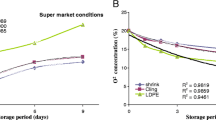Abstract
An experiment was conducted on pear fruit (cv. ‘Lagoon’) to extend the shelf life by using different packaging materials. Fruits were packed in low density polyethylene (LDPE, 0.025 mm), polypropylene (PP, 0.025 mm), linear low density polyethylene (LLDPE, 0.0125 mm) and high density polyethylene (HDPE, 0.025 mm) with or without perforation and stored at ambient condition (25 ± 2 °C and 65.0 ± 5% RH). Periodical observations were recorded on CO2 & O2 concentration (%), physiological loss in weight (PLW, %), decay loss (%), firmness (kgf), colour value (colour difference and colour index), total soluble solid (TSS, °Brix), acidity (mg of malic acid/g), and ascorbic acid loss (%) at 3 days interval. Reduced rate of PLW and decay losses was recorded in pear fruits packed in PP non-perforated (8.04%) and PP perforated (12.5%), respectively as compared to other treatments. The maximum firmness (5.18 kgf) and minimum ascorbic acid loss (49.97%) were also recorded in PP non-perforated up to 12 and 15 days of storage, respectively. It could be inferred that the, PP non-perforated (0.025 mm) was the most suitable packaging materials for extending the shelf life of pear fruits up to 15 days at ambient condition.




Similar content being viewed by others
References
Baszczyk J, Ysiak G (2001) Storage properties of Czech pear cultivars ‘Erica’ and ‘Dicolor’. J Fruit Ornam Plant Res 9:71–76
Calvo G, Salvador ME, Sanchez E (2002) Control of superficial scald in ‘Beurre d’Anjou’ pears with low oxygen levels. Acta Hortic 596:879–882
Carrillo LA, Cruz Hernandez A, Guevara Lara F, Paredes Lopez O (2003) Physico-chemical changes during ripening in storage of two varieties of prickly pear stored at 18 °C. J Food Sci Technol 40:461–464
Dou-ShiJuan, Chen-KunSong, LuJunLiang, Zheng JT (2002) The storability and its regulatory mechanism of Huanghua pear (Pyrus pyrifolia Nakai.) fruit as influenced by postharvest treatments. Agric Sci China 1:1238–1245
Dou-ShiJuan, Chen-KunSong, LuJunLiang, Zheng JT (2003) Effects of different postharvest treatments on storage of Huanghua pear fruit (Pyrus pyrifolia Nakai) and its physiological basis. Scientia Agricultura Sinica 36:82–88
Drake SR, Gix RD (2000) Response of d’Anjou pears to controlled atmosphere storage in elevated temperature and carbon dioxide. Good Fruit Grower 51:55–57
Drake SR, Gix RD, Coureau C (2001) Quality of ‘Anjou’ pears after different types of controlled atmosphere storage. J Food Qual 24:27–36
Drake SR, Mielke EA, Elfving DC (2004) Maturity and storage quality of ‘Concorde’ pears. Hortic Technol 14:250–256
Elgar HJ, Watkins CB, Murray SHF, Gunson A (1997) Quality of ‘Buerre Bose’ and ‘Doyenne du Cornice’ pears in relation to harvest date and storage period. Postharvest Biol Technol 10:29–37
Freed M (1966) Method of vitamin assay. Interscience Publication Inc., New York
Galvis Sanchez AC, Fonseca SC, Morais AMMB, Malcata FX (2003) Physicochemical and sensory evaluation of ‘Rocha’ pear following controlled atmosphere storage. J Food Sci 68:318–327
Goncalves ED, Antunes PL, Brackmann A (2000) Controlled atmosphere storage of Asian pears cv. Nijisseiki. Rev Bras Frutic 22:226–231
Hansen E, Mellenthin WM (1979) Commercial handling and storage practices for winter pears. Ore. State Univ. Agric Experimental Station, Special Report 550
Kader AA (1986) Biochemical and physiological basis for effects of controlled atmospheres on fruits and vegetables. Food Technol 40:99–104
Kader AA, Watkins CB (2000) Modified atmosphere packaging-toward 2000 and beyond. Hortic Technol 10(3):483–486
Kader AA, Zagory D, Kerbel EL (1989) Modified atmosphere packaging of fruits and vegetables. Crit Rev Food Sci Nutr 28:1–30
Kwon YB, Park SK, Myunh SI, Hong SJ (2003) Effect of postharvest treatments on fruit quality during storage of ‘Niitaka’ pear. Korean J of Hortic Sci Technol 21:114–119
Lee YJ (2001) Discoloration disorder as influenced by sealing methods of PE film bag in MAP storage of ‘Fuyu’ persimmon fruit. J Korean Soc Hortic Sci 42:721–724
Mapson CW (1970) Vitamins in fruits: stability of L-ascorbic acid. Biochemistry of fruits and their products. Academic Press, London, In, pp 376–387
Park YM (2002) Relationship between instrumental and sensory analysis of quality factors in apple and pear fruits. Korean J Hortic Sci Technol 20:394–398
Ranganna S (1995) Handbook of analysis and quality control for fruits and vegetable products, 2nd edn. Tata McGraw Hill Publishing Co. Ltd, New Delhi, India
Ribeiro CJO, Nazare PA, Sobreiro J, Veltman RH (2003) Influence of orchard, harvest date and controlled atmosphere, on storage quality of “Rocha” pear. Acta Hortic 599:639–645
Sandhu SS, Singh AP (2000) Effect of harvesting dates and individual seal packaging on the pear fruit cv. Le Conte during cold storage. Haryana J Hortic Sci 29:48–52
Saquet A, Streif J, Bangerth F (2003) Brown heart incidence in ‘Conference’ pears as affected by ATP and ADP levels and membrane lipid alterations during controlled atmosphere storage. Acta Hortic 600:839–842
Sirisomboon P, Tanaka M, Fujita S, Kojima T (2000) Relationship between the texture and pectin constituents of Japanese pear. J Texture Stud 31:679–690
Soliva FRC, Martin BO (2003) Microbiological and biochemical changes in minimally processed fresh-cut Conference pears. Eur Food Res Technol 217:4–9
Steward D, Oparka J, Johnstone C, Iannetta, PPM, Davies HV (1999) Scottish crop research institute, annual report, effect of modified atmosphere packaging (MAP) on soft fruit quality. Plant Biochem Phytochem 119–124
Streif J, Xuan H, Saquet AA, Rabus C (2001) CA-storage related disorders in ‘Conference’ pears. Acta Hortic 553:635–638
Sun-XiSheng, Wang-WenHui, Li-ZhiQiang, Feng-XiaoYuan, Zhang ZY (2000) Experiment of CA storage for Jinxiang pear variety. China Fruits 4:15–17
Tijskens LMM, Vollebregt HM (2003) Passive and semi-active modified atmosphere packaging of prickly pear cactus stems (Opuntis spp.). Acta Hortic 604:665–668
Watkins CB (2000) Responses of horticultural commodities to high carbon dioxide as related to modified atmosphere packaging. Hort Technol 10:501–506
Zerbini PE (2002) The quality of pear fruit. Acta Hortic 596:805–810
Author information
Authors and Affiliations
Corresponding author
Rights and permissions
About this article
Cite this article
Nath, A., Deka, B.C., Singh, A. et al. Extension of shelf life of pear fruits using different packaging materials. J Food Sci Technol 49, 556–563 (2012). https://doi.org/10.1007/s13197-011-0305-4
Revised:
Accepted:
Published:
Issue Date:
DOI: https://doi.org/10.1007/s13197-011-0305-4




